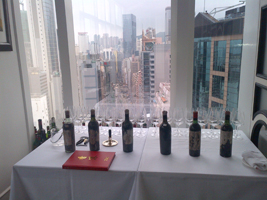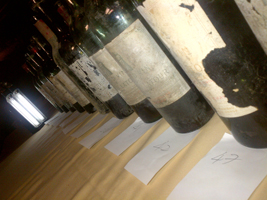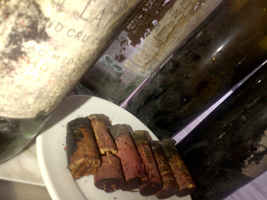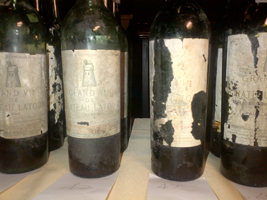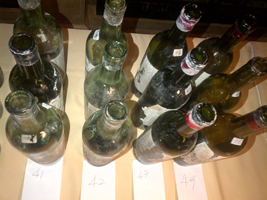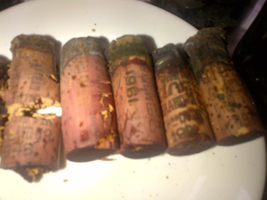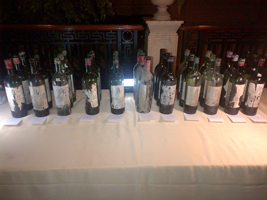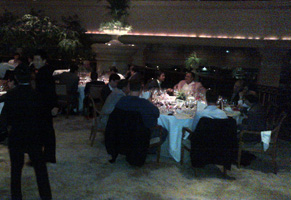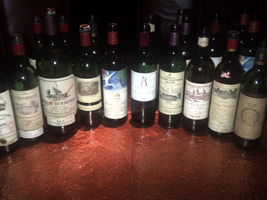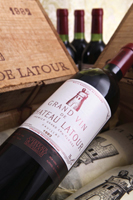I have been to many great tastings over the years, and a tasting I recently attended was as great as any. It was to celebrate someone’s 50th birthday, a FINE gentleman named Pekka, a gentleman who shares the same passion for wine as I do. Pekka and I are two birds of a feather who like to go deep into the rabbit hole, so when he asked me if I wanted in for his 50th birthday, the answer was obviously yes. When he told me the plan was to have one wine from every vintage in the 20th Century, I changed my answer to ‘Hell Yeah.’
Tasting Of The Year 2012 – Part I
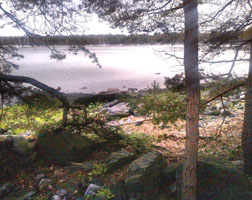
Top Secret Location
Not only was the plan to have one wine from every vintage in the 20th Century, the plan also called for only one of any given wine; ie, there wouldn’t be four vintages of Latour or Petrus etc. The plan didn’t exactly stay on course, but Pekka recalibrated to include 130 or 140 wines, so theory and practice worked out as far as my math went. Let me know if you have the patience to give me the final wine count, plus or minus three acceptable. Oh yeah, one last fact, all wines were served double-ish blind: we knew only the vintages in each flight, but not the wines, and not the order of the vintages. For the record, single blind is when you know the wines, but not the order; double blind is when you don’t know the wines or the order; triple blind is double blind with the added feature of letting your friends go into your cellar and make the selections . AC/DC wrote a song about that.
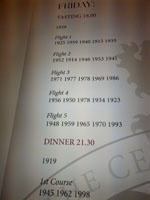
A Complex Puzzle
So how would one start a weekend of this magnitude, with a magnum of 1928 Pol Roger, of course. This original magnum (no recent disgorgement) had lightly sauteed butter and perfectly burnt white sugar in its nose. It was quite sweet, ‘normal for the period’ per SuperSomm, who has won Sommelier of the Year somewhere somehow official. Suffice it to say, he has one of great palates I have encountered, even though he is Swedish . Back to the wine, wheat, light grass and yellow fever all graced the palate, which also had just the right amount of petillance. Its sweetness was noticeable to the last sip (95M).
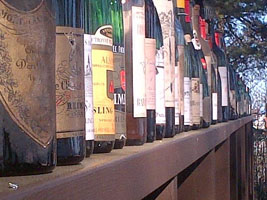
99 Bottles of Wine on the Wall
The first red wine that we had was a 1935 DRC Grands Echezeaux. You speaka my language, Pekka. Its nose was mature and tangy, ‘Burgish’ I wrote. There were lots of vitamins and rosy fruit, and while there was a touch of maderization to the nose, it was more mesquite than maderized. The mid-palate was thin, and flavors of wood, tobasco and game were noticeable first, but the wine kept improving in the glass. It got very exotic with lime, citrus and orange rind joining the party. SuperSomm added, ‘mushroom and earth’ (94).
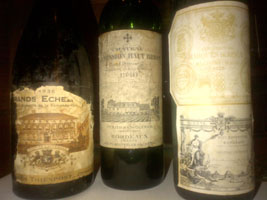
Fast and Furious Start
The second wine had a fabulous nose with aromas of decadent chocolate. Bordeaux was definitely in the house. ‘Smoky’ and ‘powerful’ came from the crowd for this dark wine. ‘So much fruit,’ I wrote, including plum and black cherry, along with great spice. The palate was delicious and mature, similar to the nose but milder, with more carob. It, too, gained in the glass and got richer. While balanced and smooth, it gained this old Burgundy complexity. I was stunned to discover this gorgeous wine was a 1940 La Mission Haut Brion. God bless old wine (95).
The third wine in this incredible, opening flight was another great nose, ‘Spain?’ I guessed. There was big-time coffee bean here, in an espresso ice cream direction. Truffle, chocolate and black fire emerged, and while the palate was again milder than the nose, it was still delicious. The nose became super smoky in a wet tobacco, leafy way. The palate had a hint of metal on the finish; it was pretty but not magnificent. Super Mario found ‘almond butter,’ and SuperSomm added ‘a bit volatile.’ It was a 1925 Marques de Riscal Rioja (93).
Back to Bordeaux?’ I questioned for the next wine. I was on an early roll. It seemed fresher and younger than the second wine, but it wasn’t younger in the end. There were wonderful garden aromas, a stick of cinnamon and great balance with its elegant plum fruit. I was in 1959 camp I must confess, but this 1915 Palmer was much older than that. There was nice balance on its citrusy and waterfall-y palate, which had touches of cedar, tobacco and caramel. While there was initially nice grit to its finish and lingering acidity, the 1915 faded quickly after fifteen minutes or so. So this rating is for the ladies, because I know they hate when that happens lol. Classy and classic, pure and super for 97 years old, the 1915 Palmer was excellent, flirting with outstanding, but it just couldn’t keep it up (92).
Spain established some early dominance thanks to a 1959 La Rioja Alta Rioja Gran Reserva 890. There was coffee again, along with milkshake, stalk, bean and beanstalk. Vanilla was there with some good wood. The palate was quite rich, actually the richest of them all so far, and its coffee, chocolate and earth flavors were lush, leathery and powerful. There was a touch of Mediterranean herbal complexity to this impressive wine(95).
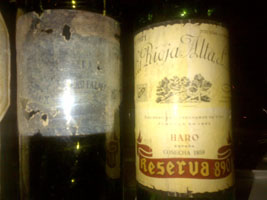
Border Dispute
The first wine of the next flight set a high bar early. It was a wild and wet Burgundy with a ‘crazy good’ nose. There was superhero-like fruit here with rose and cherry leading, but a tropical and foresty mix that exuded incredible complexity. There was a vimful spice of cedar meeting cabinet, and orange edges rounded out its abyss of a nose. The palate possessed incredible power and acidity; this bottle was in perfect condition, still so fresh and youthful. I was convinced it was from 1952, but it was not, of course. It was a 1941 DRC Richebourg. ‘Fantastic’ and ‘wow’ appeared in my notes multiple times, and mint, tomato and wild red fruits danced on the palate. This was an extraordinary wine (97).
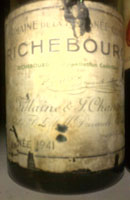
Wow
The next wine had an oaky and sickly nose with too much wood, and while the palate was better, it still had an icky finish. Soft ice cream and wood flavors were about all there was positive to say about the wine. I guess the 1914 Pavie was oaky then and still oaky now (80).
The next wine had coffee again, milder with some baked goodness. I was torn between Spain and Bordeaux. The palate was pure, smooth and lovely, and its finish spoke more of Bordeaux. ‘So complex and elegant’ came from the crowd, and this 1946 Gruaud Larose was a beautiful wine even if it wasn’t from a beautiful vintage. Those are the most thrilling of them all (93).
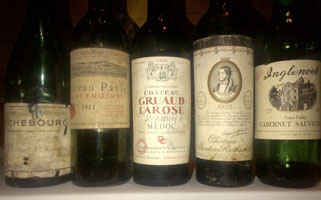
41 DRC Stands Out From the Crowd
A 1953 Mouton Rothschild was actually disappointing; perhaps it was a case of reconditioning gone wrong, as its color was quite youthful. Its nose was mild and not showy, yet it still gave a deep impression. Aromas of seashell, black fruit and pencil gave way to a soft and tender palate. Polished and pretty, there was substance there but in reserve. It felt younger than it was, even though it had mature qualities. It was polished like 1953 can be (92).
The last wine in this second flight had a gorgeous nose with aromas of wafer, caramel and a touch of mint. I was convinced this was from Italy due to its heavy leather and tar in the nose. Someone found it ‘balsamic,’ but its palate had more Cali Cabernet in that Ridge Monte Bello direction. ‘Mint chocolate’ flavors combined with caramel and a stony, gritty finish in this 1952 Inglenook Cabernet Sauvignon Cask J-9. Well done(93).
The third flight began with a wine that would have exceeded expectations and went beyond its boundaries. SuperSomm noted, ‘fresh raspberry and peach smoothie with a touch of something naughty.’ I was definitely in the Burgundy camp, ‘1971-ish,’ I wrote. If it wasn’t 1971, it had to be 1969 Rousseau, the only wine from that vintage that showed the same freshness, citricity, rose and acidity. The palate was wow times two, long and fantastic. Rose and citricity dominated, and I was stunned to see this be a 1969 DRC Romanee St. Vivant. Many 1969 DRC’s are on the drier and autumnal side, but this was a magical bottle and the greatest 1969 I have ever had, except for Rousseaus, the wines of the vintage without question(96).
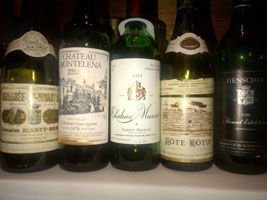
Fab Flight Freddy
The next wine had ‘moldy hay’ in its nose per Super Mario. I added ‘raining, barn, woman.’ Bad JK, bad. It was a good mold, like cheese, and it also had nice nut, earth and black/purple fruit. Its palate was elegant and balanced yet shy. It was a 1978 Chateau Montlena Napa Valley Estate Cabernet Sauvignon, which almost seemed like it needed more time(93).
The next wine had a sweet nose full of caramel, tangerine and mint. This was a delicious wine, fantastic if you will. It had that Cali mint a la old Heitz, and it was gritty and sturdy with outstanding acidity. I found this 1977 Chateau Musar outstanding, although one found it had ‘a lot of makeup’ (95).
This flight kept holding its own with a 1971 Guigal Cote-Rotie La Mouline. The nose was open with aromas of weed, forest bark, mushroom, tea, coffee, animal and bacon mixed with ham. As you can see, there was a lot going on lol. This was complicated stuff, and SuperSomm added ‘incense smoke.’ There was no doubting this was Cote Rotie, and I knew because I brought this bottle. This was delicious wine, in a gorgeous spot, released from the cold, dark cellars of The Cardinal himself. As great as the storage is in the caverns of The Cardinal, trust me when I tell you don’t go down there (95).
Dr. Brown’s celery soda was in the house thanks to a 1986 Henschke Mount Edelstone Shiraz. This was a sweet, yet great wine, SuperSomm was guessing 1977 Grange at first. It definitely had that sweet, saucy Aussie style, but it wasn’t over the top, even Goldilocks would have found it just right. It was delicious, and this flight was a great one (94).
We marched onwards with a Bloody Mary of a wine that had tobasco and Worcestershire aromas. It had that edge of maturity like the 1935 DRC, but it would end up being much younger. While clean and polished, the 1978 Bonneau Chateauneuf du Pape Reserve des Celestins didn’t deliver much pizazz. I have never been impressed with this vintage of this wine; I think Henri must have just missed this one, as Bonneau can make superstar wines. But in this superstar vintage, that was not the case (92).
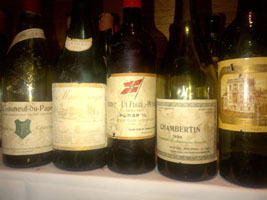
Yes, Please, May I Have Another?
The party started crashing hard thanks to a 1956 Undurraga Cabernet Sauvignon Reserva, a Chilean Cabernet. They should have kept this bottle in Chile. It had a yogurt nose with signs of Bordeaux behind it, but the yogurt stuck to the palate, and Batman found it ‘volatile and unpleasant.’ It was drinkable but barely legal for admission requirements. I have never liked Chilean wines. Sorry (80).
A 1950 La Fleur Petrus was Bordeaux at first smell, with a great balance of chocolate, caramel and coffee. It had dark Bordeaux fruits and nice acidity. This Pomerol still had lots to give and was a solid wine from this cult vintage (93).
Nail polish remover’ was in the nose of this next wine, per SuperSomm. There was huge acidity and lots of power in this monster of a Burgundy. I couldn’t believe this was from 1934, and even more that it was bottled in 1937 (and not reconditioned). This bottle of 1934 Gaston-Roupnel Chambertin showed the power and acid of 1934, one of the all-time great vintages, but this bottle came up short on its fruit and flavors (89).
There was ‘Swedish chewing tobacco’ in 1923 Ducru Beaucaillou per the SuperSomm. It had a nice nose with classic garden, some exotic fruit and hints of game. The palate was lush and tasty, a bit exotic with flavors of banana leaf (94).
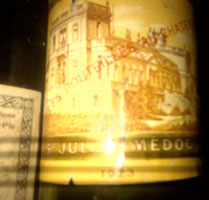
1923
It started to get tough out there during the next flight, the last before dinner. A 1948 Leoville Barton had a beautiful nose of carob, caramel and toffee, all dry. There was some hay and straw as well, but the palate was a bit short and simple(89).
A 1959 Palmer was rather disappointing, as this wine can be much better. It had a forward, heady nose with lots of saucy blood and vitamins in its nose. The palate was smooth and easy, and although there was excellent acidity in this bottle, it wasn’t special, and we had had too many great wines to dilly dally now (90).
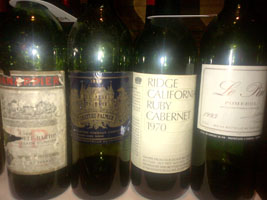
Losing Momentum
Perhaps a bit of palate fatigue was setting in, as I have great memories of 1970 Ridge Monte Bello Cabernet Sauvignon, but this bottle wasn’t one of them. Pekka found it ‘a bit peculiar, but I like it.’ There was glue and paint on top of cedar and anise aromas, with flavors of hot earth and minerals (92).
SuperSomm kept firing away, this time with ‘autumn forest, smoke and truffle’ in the 1993 Le Pin. This was definitely an XXX wine, dirty and open with lots of earth and flesh. SuperSomm added ‘kissemura,’ which is slang for something in Swedish. Here, kitty kitty (92).
Somehow, I missed taking a note on the 1965 Barca Velha Ferreira, a dry red wine from Portugal, but it was supposedly served. I think I remember it . It was time to eat.
Dinner was preceded by a 1919 Ruinart. It was a bit musty and woolly at first, and SuperMario noted ‘maple syrup.’ Batman added ‘chocolate.’ There were caramel and maple flavors in this smooth, gamy yet ‘beautiful’ (Pekka) Champagne. ‘Gunsmoke’ and ‘butterscotch’ came from the crowd. Despite some initial morning mouth, the 1919 blossomed into a luscious wine with a caramel core and apricot skin flavors. Mad Mika didn’t like the finish(93A).
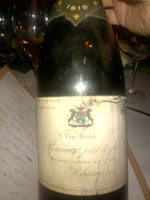
93 Years Old & Still Kicking
The first white served with dinner was a glorious 1945 Schloss Vollrads Rheingau Riesling Kabinett. The nose was full of peach skin along with some yogurt, but a good yogurt unlike the Chilean one. There was some baked honey also in the nose, which gave way to flavors of the same along with marmalade. Lemon, citrus and petrol were all tastily there in this magnificent old Riesling (95).
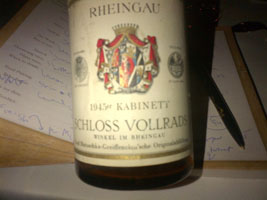
1945 Greatness
There were very few wines on this weekend that I found so bad, they didn’t deserve a number…ie, a score below 80. The 1962 Carbonnieux Blanc was one of them. It was hideously oaky and the palate was awful. Glue, green and apple were about all I could say, but it wasn’t enough in any which way (NR).
The third white quickly recalibrated my wine sense with a zippy, perfect bottle of 1998 Coche-Dury Corton Charlemagne. Its signature white fruits, minerals and kink were all on fine display in this fresh bottle, and its finish said it still had plenty of life left in it (94).
The reds started with a classy and classic 1943 Calon Segur (91).Aromas and flavors of earth, cedar, tobacco and cassis came together in this smooth, polished and easy wine. Some violets emerged with time (91).
A 1983 Opus One was kind of oaky and disappointing. Ehhhhh (84).
I couldn’t write much more than ‘I’m done!’ for a 2000 DRC La Tache. I wasn’t kidding (92)
There was a corked 1918 Coutet (DQ) and a decent 1902 Boal Madeira from Lord-knows-who (93).
And that was Day One of the Tasting of the Year.
In Vino Veritas,
JK

